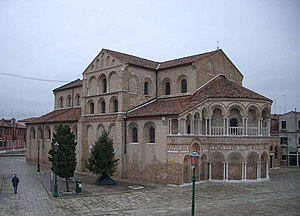Difference between revisions of "Murano"
m |
m |
||
| Line 1: | Line 1: | ||
{{X}} | {{X}} | ||
[[Image:MuranoFotoBullo20031230.JPG|thumb|A shop with boats, Murano]] | [[Image:MuranoFotoBullo20031230.JPG|thumb|A shop with boats, Murano]] | ||
| + | |||
'''Murano''' is usually described as an [[island]] in the [[Venetian Lagoon]], although like [[Venice]] itself it is actually an [[archipelago]] of islands linked by bridges. It lies about a mile north of Venice and is famous for its [[glass making]], particularly [[lampworking]]. | '''Murano''' is usually described as an [[island]] in the [[Venetian Lagoon]], although like [[Venice]] itself it is actually an [[archipelago]] of islands linked by bridges. It lies about a mile north of Venice and is famous for its [[glass making]], particularly [[lampworking]]. | ||
Revision as of 12:01, 18 September 2009
Murano is usually described as an island in the Venetian Lagoon, although like Venice itself it is actually an archipelago of islands linked by bridges. It lies about a mile north of Venice and is famous for its glass making, particularly lampworking.
Murano was settled by the Romans, then from the sixth century by people from Altino and Oderzo. At first, the island prospered as a fishing port and through production of salt. It was also a centre for trade, through the port it controlled on Sant'Erasmo. From the eleventh century, it began to decline as islanders moved to Dorsoduro. It had a Grand Council, like that of Venice, but from the thirteenth century Murano was ultimately governed by a podesta from Venice. Unlike the other islands in the Lagoon, Murano minted its own coins.
In 1291, all the glassmakers in Venice were forced to move to Murano due to the risk of fires. In the following century, exports began, and the island became famous, initially for glass beads and mirrors. Aventurine glass was invented on the island, and for a while Murano was the main producer of glass in Europe. The island later became known for chandeliers. Although decline set in during the eighteenth century, glassmaking is still the island's main industry.
In the fifteenth century, the island became popular as a resort for Venetians, and palaces were built, but this later declined. The countryside of the island was known for its orchards and vegetable gardens until the nineteenth century, when more housing was built.
Attractions on the island include the Church of Santa Maria e San Donato, known for its twelfth century Byzantine mosaic pavement and said to house the bones of the dragon slain by Saint Donatus, the Church of San Pietro Martire and the Palazzo da Mula. Glass-related attractions include the many glassworks, some Mediaeval and most open to the public, and the Glass Museum, housed in the large Palazzo Giustinian.


